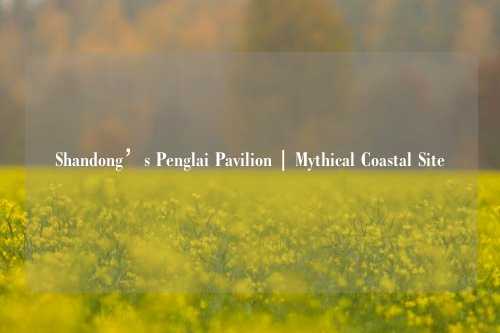Shandong’s Penglai Pavilion | Mythical Coastal Site
Shandong’s Penglai Pavilion is one of China’s most enchanting historical sites, renowned for its breathtaking coastal scenery and deep-rooted connections to ancient mythology. Perched on a cliff overlooking the Bohai Sea, this centuries-old architectural complex has inspired poets, scholars, and travelers for generations. Often associated with legends of immortality and divine encounters, the pavilion holds a special place in Chinese cultural history.
A Historic Landmark with Legendary Origins
Penglai Pavilion dates back to the Song Dynasty, with its earliest construction recorded in 1061 during the reign of Emperor Renzong. Over the centuries, it has undergone numerous expansions and restorations under different dynasties, including the Yuan, Ming, and Qing. The site consists of an array of temples, halls, and towers, each offering a glimpse into China’s architectural traditions and religious influences.

This location is famously linked to the legend of the Eight Immortals crossing the sea, a story deeply embedded in Daoist folklore. According to ancient tales, these celestial beings embarked on a journey across the Bohai Sea, using their supernatural powers rather than conventional boats. This narrative has made Penglai Pavilion a spiritual site, attracting Daoist practitioners and those intrigued by mythical lore.
Architectural Grandeur and Scenic Beauty
The pavilion’s architectural style reflects the elegance of classical Chinese construction, with its sweeping eaves, intricate carvings, and layered rooftops blending harmoniously with the natural surroundings. Standing at the highest point of the complex, visitors can admire panoramic views of the vast sea, where mist often merges the horizon, creating an illusion of floating islands. This phenomenon, referred to as the "Penglai Mirage," has fascinated observers for centuries and contributed to the area’s legendary status.
Among the key structures within the complex, the Sanqing Palace is particularly significant. Dedicated to the Three Pure Ones, the highest deities in Daoism, this hall serves as a place of worship and reflection. Other important sites include the Dragon King Temple, where fishermen and sailors once prayed for safe voyages, and the Tianhou Palace, dedicated to the sea goddess Mazu.
The Penglai Mirage – A Natural Phenomenon
One of the most captivating aspects of Penglai Pavilion is the rare optical illusion known as the "Penglai Mirage." On certain days, especially in summer, visitors can witness a phenomenon where distant objects appear to hover above the sea, creating the illusion of an otherworldly realm. This occurrence, documented in historical texts as early as the Han Dynasty, has reinforced the belief that Penglai is the earthly gateway to a celestial paradise.
Ancient scholars and travelers often described this vision as evidence of an immortal land beyond human reach. The mysterious nature of the mirage continues to draw scientists and tourists alike, each hoping to witness the awe-inspiring spectacle firsthand.
Connection to the Qin Dynasty and the Quest for Immortality
Penglai Pavilion is also linked to the famous tale of Qin Shi Huang, China’s first emperor, who reportedly sent expeditions to this region in search of the elixir of life. Historical records suggest that in the 3rd century BCE, the emperor dispatched emissaries, including the alchemist Xu Fu, to find Penglai and its promised immortality. Although the search yielded no results, the story further cemented Penglai’s reputation as a mystical place where heaven and earth converge.
Cultural Influence in Poetry and Literature
Throughout Chinese history, Penglai Pavilion has been a source of inspiration for poets, painters, and writers. Many well-known literary figures have left behind verses praising its beauty, mystique, and the dreamlike quality of its coastal landscape. Song Dynasty poets often referenced the site in their works, depicting it as a gateway to divine realms beyond human comprehension.
Classical Chinese paintings also frequently feature Penglai Pavilion, often portraying it as a celestial palace rising above mist-covered waters. This artistic representation has reinforced the pavilion’s role in Chinese cultural memory as a place where mythology and reality intertwine.
A Journey Through Time
Visiting Penglai Pavilion today allows travelers to step into a world where history, mythology, and breathtaking scenery come together. As visitors ascend its stone stairways and walk through its ancient halls, they can reflect on the countless individuals who have stood in the same spot over centuries, gazing out at the boundless sea in wonder.
For those interested in both history and nature, the pavilion offers an experience unlike any other, capturing the imagination with its legendary past and stunning coastal views. Whether drawn by the promise of myth or the simple pleasure of admiring China’s coastal beauty, Penglai Pavilion remains a place where the past and present exist in harmony.
















